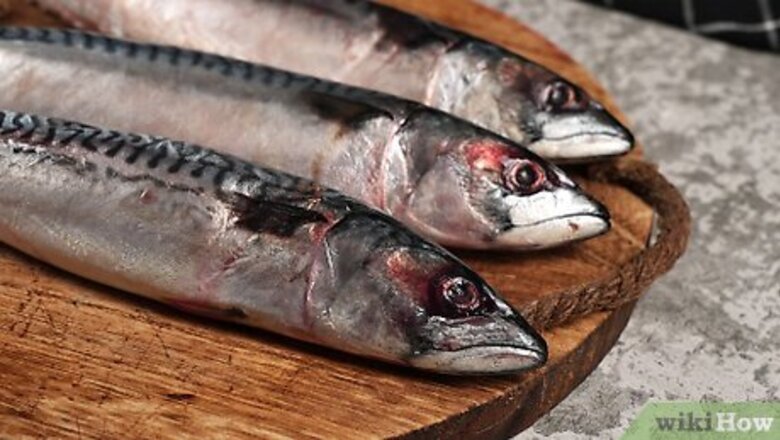
views
Killing and Scaling the Fish

Knock out and kill your fish if it isn’t already dead. If you’ve just caught your fish, you’ll need to subdue it and kill it before you can clean and gut it. Hold the fish down on a firm, flat surface with your nondominant hand centered on the abdomen. Use a club or heavy, blunt object to strike the top of the head to render it unconscious. Then, puncture the fish’s brain with a spike or thin knife by sticking it through the head directly behind and slightly above the eye. Jiggle the spike or knife around in the head to ensure that you fully cut through the brain. While you can kill a fish by repeatedly striking it with a blunt object, spiking the brain is considered to be the most humane method of dispatching a fish.

Rinse your catch in cool water to clean it. Set your fish up in a sink or cleaning station. Place your fish under a stream of cold water and rub its body with both hands. A precursory rinse will get the slime, dirt, and debris off of the scales. This will prevent unwanted objects from getting into the body of the fish when you cut it. If you’re using a cleaning station, always discard the carcass and guts in the grinder, and clean up after yourself when you’re done. You can wear rubber gloves if you want to keep your hands clean while you work.
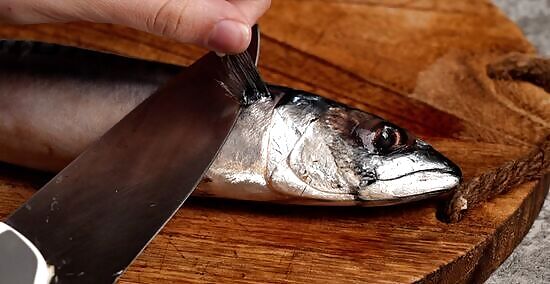
Remove the fins from the fish by cutting them off. While it isn’t mandatory, you can make the cleaning process easier by removing the fins. Hold the tip of a fin up in the air with your nondominant hand. Place a filet knife at the base of the fin and slide your knife through it. Remove any large fins that you think will get in the way during the cleaning process. Depending on the species, the dorsal fins may be particularly long and hard to remove. Cut lengthwise through them in small sections to make the process easier. You can really use any sharp knife to clean and gut a fish, but a flexible filet knife is preferable because the thin blade will keep you from shredding the flesh.

Scale the fish by scraping the side with the back of your knife. Place the fish in a large sink or cleaning area. Hold the tail in your nondominant hand and raise it up so that the fish’s body rests at a 45-degree angle. Hold your knife firmly in your dominant hand and scrape the scales with the blunt side of your knife in long, hard swipes. Start at the tail and scrape your way towards the head. Flip the fish over and repeat the process to scale the other side.Tip: For tough-skinned species, you can use the sharp edge of your knife. Just be careful and make sure that the blade scrapes along the top of the scales and not into the flesh of the fish. Rinse your fish after scaling it to keep any loosened scales from getting into your fish’s abdominal cavity. You can scale the fish after you’ve gutted it if you prefer.
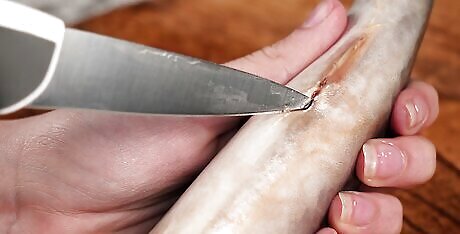
Slide the tip of the knife into the vent of the fish. On a stable cutting surface, line your fish up so that the belly is facing you. Tilt the fish at a 45-degree angle with the head facing away from you. With the sharp side of your filet knife facing the fish’s head, slide the tip of your filet knife into the anus of the fish. Insert it 1–2 inches (2.5–5.1 cm) into the vent depending on the size of your catch. The vent is the lowest portion of a fish’s underside. The fish’s anus is the small opening near the bottom of the tail section. It is usually a different color from the rest of the fish’s vent.
Cut your way up towards the neck. Keep a firm grip on your knife and move it up and down in 0.5 in (1.3 cm) intervals as you slide it through the vent of the fish. Continue cutting until you’ve reached 1–2 inches (2.5–5.1 cm) beneath the fish’s mouth. You don’t want to cut too deeply into the fish’s belly as you’re cutting it. If you rupture the intestines you’ll end up with a nasty mess inside of your fish. You can choose to cut through the throat and the gills as you’re finishing the cut if you plan on removing the head later.
Gutting the Fish
Spread the stomach open and remove the guts and entrails. Without ripping your cut, carefully spread the two sides of the fish open 2–6 inches (5.1–15.2 cm) at the vent. Reach near the head of the fish and pinch the organs where they connect to the head between your thumb and index finger. Gently pull them out at the root. Reach towards the tail of the fish and slowly pull out the guts and entrails.Tip: Physically pulling out the guts, gills, and entrails should be relatively easy. There shouldn’t be much resistance and you shouldn’t need to cut anything with your knife. Inspect the body cavity for any remaining organs and remove them by hand. Discard the organs in an appropriate trash bin. At a cleaning station, drop them in the grinder to get rid of them.

Scoop out the fish’s kidney by the spine if it has one. Some fish have a small kidney on the inside of their spine near their midsection. Look along the interior side of the spine for a small bean-shaped organ. If your fish has a kidney, scoop it out with a spoon.
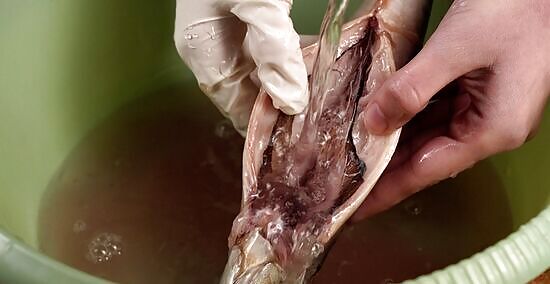
Rinse your fish under cold water and clean the abdominal cavity. In a large sink or cleaning area, hold your fish vent-side up. Turn on a steady stream of cold water and spread the stomach open. Let the water run through your fish’s abdominal cavity while you use your hands or a spoon to rub the interior walls of your fish’s body. This will remove any remaining residue from the organs and clean the flesh. Wash your fish for at least 1 minute to ensure that every part of the fish’s abdominal cavity gets rinsed.
Filleting a Fish
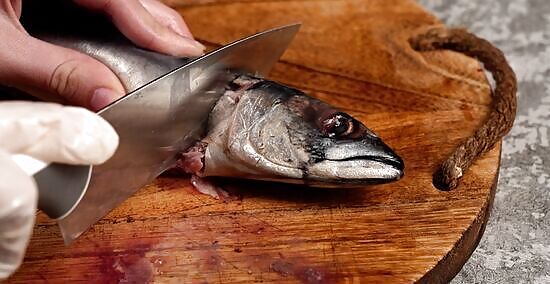
Remove the head if you don’t plan on using it. Lay your fish flat on a cutting surface. Locate the fish’s gills and move your knife 1–2 in (2.5–5.1 cm) behind them. With your blade facing downwards, turn your knife slightly towards the head. Brace the fish’s body with your nondominant hand while you cut at a 15-degree angle down to the spine. Flip the fish over and repeat the cut on the opposite side.Tip: You can cut directly downwards behind the gills if you’d like, but there’s a good chunk of flesh that you’re leaving behind if you do that. There’s a lot of flesh stored in the fish’s body right under the gills. Cutting at an angle ensures that you leave it intact. If the head isn’t fully removed by your 2 cuts, you can grip it and twist it off to fully remove it. Some fish, like trout, are traditionally cooked with the head still attached.
Cut through the fish’s spine to create fish steaks. With the head removed, take a steak knife and rest the blade across the fish’s body so that your blade is perpendicular to the spine. Place your knife 2–3 inches (5.1–7.6 cm) from the opening at the neck and slide the knife back and forth along the same line until you’ve cut all the way through the fish’s body to create a steak. Repeat this process leaving 1 inch (2.5 cm) of flesh between each cut to steak an entire fish. The difference between a steak and a filet is whether or not the bone was cut through. A steak is a cut through the bone, while a filet is cut around the bone.
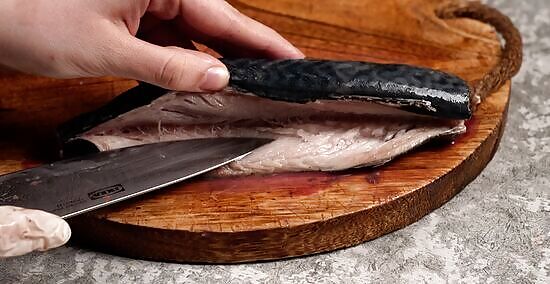
Turn the fish’s spine towards you and cut above the backbone to start a filet. Put your finger on the blunt edge of your filet knife and poke your knife through the back of the fish, right above the spine. Slide your filet knife sideways through the bottom of the fish. Maneuver the knife slowly through the entire length of your catch, keeping your filet knife parallel to the spine. Keep your knife ⁄8–⁄2 inch (0.32–1.27 cm) above the backbone, depending on the side of your fish. You may need to bend over a little bit to get good angle for your cut. You can place your nondominant thumb on the opening created by your initial cut to peel the skin back and make cutting easier.
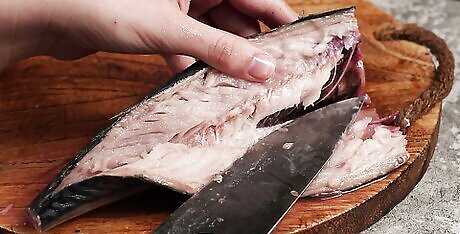
Peel the side of the fish up to cut a fillet out. Use your nondominant hand to peel the flesh open so that the fish’s side is exposed at 35-45 degrees. Use small cuts to slice through any connecting tissue at the base of the fish’s side to fully remove your fillet. Peel the fillet off of the fish’s body and set it aside. Flip the fish over and repeat this process on the opposite side. You can carve around any bones that you encounter if you’d like. Depending on the fish’s species and size, you may want to do this when you’re preparing to cook though to avoid accidentally removing any flesh. Rotate the fish as you flip it over so that you stay facing the spine. For the second fillet, start at the tail end and cut towards the head. You can peel or cut the thin layer of skin off of your filets if you’d like to, although many recipes require the skin to stay on during cooking.

















Comments
0 comment